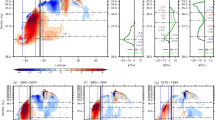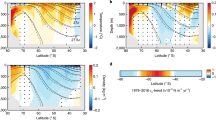Abstract
Ocean overturning circulation requires a continuous thermodynamic transformation of the buoyancy of seawater. The steeply sloping isopycnals of the Southern Ocean provide a pathway for Circumpolar Deep Water to upwell from mid depth without strong diapycnal mixing1,2,3, where it is transformed directly by surface fluxes of heat and freshwater and splits into an upper and lower branch4,5,6. While brine rejection from sea ice is thought to contribute to the lower branch7, the role of sea ice in the upper branch is less well understood, partly due to a paucity of observations of sea-ice thickness and transport8,9. Here we quantify the sea-ice freshwater flux using the Southern Ocean State Estimate, a state-of-the-art data assimilation that incorporates millions of ocean and ice observations. We then use the water-mass transformation framework10 to compare the relative roles of atmospheric, sea-ice, and glacial freshwater fluxes, heat fluxes, and upper-ocean mixing in transforming buoyancy within the upper branch. We find that sea ice is a dominant term, with differential brine rejection and ice melt transforming upwelled Circumpolar Deep Water at a rate of ∼22 × 106 m3 s−1. These results imply a prominent role for Antarctic sea ice in the upper branch and suggest that residual overturning and wind-driven sea-ice transport are tightly coupled.
This is a preview of subscription content, access via your institution
Access options
Subscribe to this journal
Receive 12 print issues and online access
$259.00 per year
only $21.58 per issue
Buy this article
- Purchase on Springer Link
- Instant access to full article PDF
Prices may be subject to local taxes which are calculated during checkout



Similar content being viewed by others
References
Toggweiler, R. & Samuels, B. Effect of Drake Passage on the global thermohaline circulation. Deep-Sea Res. I 42, 477–500 (1995).
Wolfe, C. & Cessi, P. The adiabatic pole-to-pole overturning circulation. J. Phys. Oceanogr. 41, 1795–1810 (2011).
Nikurashin, M. & Vallis, G. A theory of the interhemispheric meridional overturning circulation and associated stratification. J. Phys. Oceanogr. 42, 1652–1667 (2012).
Speer, K., Rintoul, S. & Sloyan, B. The diabatic Deacon cell. J. Phys. Oceanogr. 30, 3212–3223 (2000).
Marshall, J. & Speer, K. Closing the meridional overturning circulation through Southern Ocean upwelling. Nature Geosci. 5, 171–180 (2012).
Talley, L. D. Closure of the global overturning circulation through the Indian, Pacific and Southern Oceans: schematics and transports. Oceanography 26, 80–97 (2013).
Jacobs, S. Bottom water production and its links with the thermohaline circulation. Antarct. Sci. 4, 427–437 (2004).
Ren, L., Speer, K. & Chassignet, E. P. The mixed layer salinity budget and sea ice in the Southern Ocean. J. Geophys. Res. 116, C08031 (2011).
Tamura, T., Ohshima, K. I., Nihashi, S. & Hasumi, H. Estimation of surface heat/salt fluxes associated with sea ice growth/melt in the Southern Ocean. Sci. Online Lett. Atmos. 7, 17–20 (2011).
Walin, G. On the relation between sea-surface heat flow and thermal circulation in the ocean. Tellus 34, 187–195 (1982).
Talley, L. D. Freshwater transport estimates and the global overturning circulation: shallow, deep and throughflow components. Prog. Oceanogr. 78, 257–303 (2008).
Holland, P. R. & Kwok, R. Wind-driven trends in Antarctic sea-ice drift. Nature Geosci. 5, 872–875 (2012).
Hasumi, H. & Suginohara, N. Haline circulation induced by formation and melting of sea ice. J. Geophys. Res. 100, 20613–20625 (1995).
Stoessel, A., Kim, S. & Drijfhout, S. B. The impact of Southern Ocean sea ice in a global ocean model. J. Phys. Oceanogr. 28, 1999–2018 (1998).
Komuro, Y. & Hasumi, H. Effects of surface freshwater flux induced by sea ice transport on the global thermohaline circulation. J. Geophys. Res. 108, 3047 (2003).
Saenko, O. A., Schmittner, A. & Weaver, A. J. On the role of wind-driven sea ice motion on ocean ventilation. J. Phys. Oceanogr. 32, 3376–3395 (2002).
Iudicone, D., Madec, G., Blanke, B. & Speich, S. The role of Southern Ocean surface forcings and mixing in the global conveyor. J. Phys. Oceanogr. 38, 1377–1400 (2008).
Marshall, J., Jamous, D. & Nilsson, J. Reconciling thermodynamic and dynamic methods of computation of water-mass transformation rates. Deep-Sea Res. I 46, 545–572 (1999).
Urakawa, L. & Hasumi, H. Eddy-resolving model estimate of the cabbeling effect on the water mass transformation in the Southern Ocean. J. Phys. Oceanogr. 42, 1288–1302 (2012).
Downes, S. M., Gnanadesikan, A., Griffies, S. M. & Sarmiento, J. L. Water mass exchange in the Southern Ocean in coupled climate models. J. Phys. Oceanogr. 41, 1756–1771 (2011).
Garrett, C. & Tandon, A. The effects on water mass formation of surface mixed layer time-dependence and entrainment fluxes. Deep-Sea Res. I 44, 1991–2006 (1997).
Gordon, A. L. & Huber, B. A. Southern Ocean winter mixed layer. J. Geophys. Res. 95, 11544–11672 (1990).
Martinson, D. Evolution of the Southern Ocean winter mixed layer and sea ice: open ocean deepwater formation and ventilation. J. Geophys. Res. 95, 11641–11654 (1990).
Cerovečki, I., Talley, L. D. & Mazloff, M. Subantarctic mode water formation, destruction, and export in the eddy-permitting Southern Ocean State Estimate. J. Phys. Oceanogr. 42, 1485–1511 (2012).
Cerovečki, I. & Mazloff, M. R. The spatiotemporal structure of diabatic processes governing the evolution of Subantarctic Mode Water in the Southern Ocean. J. Phys. Oceanogr. 46, 683–710 (2016).
Wong, A. P. S. & Riser, S. C. Profiling float observations of the upper ocean under sea ice off the Wilkes Land coast of Antarctica. J. Phys. Oceanogr. 41, 1102–1115 (2011).
Cavalieri, D., Parkinson, C. & Vinnikov, K. Y. 30-year satellite record reveals contrasting Arctic and Antarctic decadal sea ice variability. Geophys. Res. Lett. 30, 1970 (2003).
Stephens, B. B. & Keeling, R. F. The influence of Antarctic sea ice on glacial–interglacial CO2 variations. Nature 404, 171–174 (2000).
Ferrari, R. et al. Antarctic sea ice control on ocean circulation in present and glacial climates. Proc. Natl Acad. Sci. USA 111, 8753–8758 (2014).
Wunsch, C. Determining the general circulation of the oceans: a preliminary discussion. Science 196, 871–875 (1977).
Wunsch, C. & Heimbach, P. in Ocean Circulation and Climate: A 21st Century Perspective Vol. 103 (eds Siedler, G., Gould, J. & Griffies, S. M.) Ch. 21, 553–579 (International Geophysics, Academic, 2013); http://www.sciencedirect.com/science/article/pii/B9780123918512000210
Forget, G. et al. ECCO version 4: an integrated framework for non-linear inverse modeling and global ocean state estimation. Geosci. Model Dev. Discuss. 8, 3653–3743 (2015); http://www.geosci-model-dev-discuss.net/8/3653/2015
Mazloff, M., Heimbach, P. & Wunsch, C. An eddy permitting Southern Ocean state estimate. J. Phys. Oceanogr. 40, 880–899 (2010).
Mazloff, M., Ferrari, R. & Schneider, T. The force balance of the Southern Ocean meridional overturning circulation. J. Phys. Oceanogr. 43, 1193–1208 (2013).
Sebille, E. et al. Abyssal connections of Antarctic Bottom Water in a Southern Ocean state estimate. Geophys. Res. Lett. 40, 2177–2182 (2013).
Cerovečki, I., Talley, L. D. & Mazloff, M. R. A comparison of Southern Ocean air-sea buoyancy flux from an ocean state estimate with five other products. J. Clim. 24, 6283–6306 (2011).
Abernathey, R., Marshall, J., Shuckburgh, E. & Mazloff, M. Enhancement of mesoscale eddy stirring at steering levels in the Southern Ocean. J. Phys. Oceanogr. 40, 170–185 (2010).
Ito, T., Woloszyn, M. & Mazloff, M. Anthropogenic carbon dioxide transport in the Southern Ocean driven by Ekman flow. Nature 463, 80–83 (2010).
Marshall, J., Adcroft, A., Hill, C., Perelman, L. & Heisey, C. A finite-volume, incompressible Navier Stokes model for studies of the ocean on parallel computers. J. Geophys. Res. 102, 5753–5766 (1997).
Marshall, J., Hill, C., Perelman, L. & Adcroft, A. Hydrostatic, quasi-hydrostatic, and nonhydrostatic ocean modeling. J. Geophys. Res. 102, 5733–5752 (1997).
Large, W. G., McWilliams, J. C. & Doney, S. C. Oceanic vertical mixing: a review and a model with a nonlocal boundary layer parameterization. Rev. Geophys. 32, 363–403 (1994).
Losch, M., Menemenlis, D., Campin, J., Heimbach, P. & Hill, C. On the formulation of sea-ice models. Part 1: effects of different solver implementations and parameterizations. Ocean Modelling 33, 129–144 (2010).
Forget, G. Mapping ocean observations in a dynamical framework: a 2004–06 ocean atlas. J. Phys. Oceanogr. 40, 1201–1221 (2010).
Kalnay, E. et al. The NCEP/NCAR 40-year reanalysis project. Bull. Am. Meteorol. Soc. 77, 437–471 (1996).
Dee, D. et al. The ERA-Interim reanalysis: configuration and performance of the data assimilation system. Q. J. R. Meteorol. Soc. 137, 553–597 (2011).
Large, W. G. & Yeager, S. G. The global climatology of an interannually varying air–sea flux data set. Clim. Dynam. 33, 341–364 (2009).
Fekete, B. M., Vöröosmarty, C. J. & Grabs, W. High-resolution fields of global runoff combining observed river discharge and simulated water balances. Glob. Biogeochem. Cycles 16, 15-1–15-10 (2002).
Comiso, J. Bootstrap Sea Ice Concentrations from Nimbus-7 SMMR and DMSP SSM/I-SSMIS version 2 (Technical Report, NASA DAAC at the National Snow and Ice Data Center, 2000).
Cavalieri, D., Parkinson, C., Gloersen, P. & Zwally, H. J. Sea Ice Concentrations from Nimbus-7 SMMR and DMSP SSM/I-SSMIS Passive Microwave Data version 1 (Technical Report, NASA DAAC at the National Snow and Ice Data Center, 1996).
Markus, T. & Cavalieri, D. J. An enhancement of the NASA team sea ice algorithm. IEEE Trans. Geosci. Remote Sens. 38, 1387–1398 (2000).
Fenty, I. G. & Heimbach, P. Coupled sea ice-ocean state estimation in the Labrador Sea and Baffin Bay. J. Phys. Oceanogr. 43, 884–904 (2013).
Heuzé, C., Heywood, K. J., Stevens, D. P. & Ridley, J. K. Southern Ocean bottom water characteristics in CMIP5 models. Geophys. Res. Lett. 40, 1409–1414 (2013).
Toggweiler, J. R. & Samuels, B. Effect of sea ice on the salinity of Antarctic bottom waters. J. Phys. Oceanogr. 25, 1980–1997 (1995).
Stewart, A. L. & Thompson, A. F. Connecting Antarctic cross-slope exchange with Southern Ocean overturning. J. Phys. Oceanogr. 43, 1453–1471 (2013).
Heywood, K. J. et al. Ocean processes at the Antarctic continental slope. Phil. Trans. R. Soc. A 372, 20130047 (2014).
Holland, P. R. et al. Modeled trends in Antarctic sea ice thickness. J. Clim. 27, 3784–3801 (2014).
Acknowledgements
R.P.A. acknowledges support from NSF grant OCE-1357133. I.C., L.D.T. and M.M. acknowledge support from NSF grant OCE-1357072. L.D.T. and M.M. acknowledge additional support from NSF grant PLR-1425989, and M.M. from OCE-1234473. I.C. acknowledges additional support from the New International Fellowship Mobility Programme for Experienced Researchers—NEWFELPRO under the European Union’s Seventh Framework Programme for research, technological development and demonstration (FP7-PEOPLE-2011-COFUND-MCA). We acknowledge high-performance computing support from Yellowstone (ark:/85065/d7wd3xhc) provided by NCAR’s Computational and Information Systems Laboratory, sponsored by the National Science Foundation, and from the Yeti HPC cluster, provided by Columbia University Research Computing Services. SOSE was produced with support from NSF-XSEDE grant OCE130007.
Author information
Authors and Affiliations
Contributions
All authors contributed to the interpretation of the results and writing of the manuscript. R.P.A. designed the study, implemented the water-mass calculations, and conducted the validation against ship-based and sea-ice observations. I.C. contributed to the water-mass analysis and validation of SOSE against ARGO observations. P.R.H. contributed to the analysis of sea-ice thermodynamics. E.N. contributed to the water-mass analysis. M.M. developed SOSE and contributed to model validation. L.D.T. contributed to interpretation of the transformation rates.
Corresponding author
Ethics declarations
Competing interests
The authors declare no competing financial interests.
Supplementary information
Supplementary Information
Supplementary Information (PDF 16230 kb)
Rights and permissions
About this article
Cite this article
Abernathey, R., Cerovecki, I., Holland, P. et al. Water-mass transformation by sea ice in the upper branch of the Southern Ocean overturning. Nature Geosci 9, 596–601 (2016). https://doi.org/10.1038/ngeo2749
Received:
Accepted:
Published:
Issue Date:
DOI: https://doi.org/10.1038/ngeo2749
This article is cited by
-
Impacts of Ice-Ocean Stress on the Subpolar Southern Ocean: Role of the Ocean Surface Current
Advances in Atmospheric Sciences (2024)
-
Isotopic evidence for an intensified hydrological cycle in the Indian sector of the Southern Ocean
Nature Communications (2023)
-
Abyssal ocean overturning slowdown and warming driven by Antarctic meltwater
Nature (2023)
-
A deep-learning estimate of the decadal trends in the Southern Ocean carbon storage
Nature Communications (2022)
-
Sources, sinks, and cycling of dissolved organic copper binding ligands in the ocean
Communications Earth & Environment (2022)



